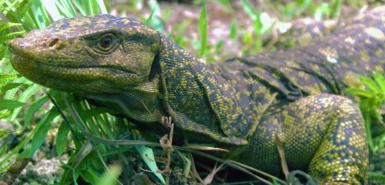
December 21, 2010

Top Ten Cryptozoology Stories of 2010
by Loren Coleman, True Giants, Cryptozoology A to Z, and other books.

The Year of 2010 may be remembered, in popular culture, cryptozoologically, for its series of stories of cryptids such as a blond Bigfoot named Knobby, on misidentifications of common animals, of announcements of a few remarkable discoveries, and about groundbreaking new concepts on tribal Sasquatch and extraordinary True Giants.
Let’s look at the top ten memorable news items.
1. Fruit-eating monitor discovery.

A dragon-sized, fruit-eating lizard (Varanus bitatawa) that was ethnoknown to locals but unknown to Western science was discovered on the northern Philippines island of Luzon. Scientists confirmed it as a new species, on April 6, 2010. The six feet-long (two meter-long) monitor climbs trees and is only the third fruit-eating lizard known in the world.

Many new species of monitor lizards were newly discovered in 2010, although the media did not mention this fact often. Some say the number of new monitor species announced was six, but most definitely noted at least five.
2. Oriental Yeti mania.

This bizarre creature dubbed the “Oriental Yeti” supposedly baffled scientists, after allegedly emerging from “ancient woodlands in remote central China,” said media reports from Asia and elsewhere. The news hit the wire services the same day as the monitor lizard discovery. Guess what event received more attention?

What began as a “Chinese Chupacabras” story, evolved into the “Oriental Yeti” hysteria, which turned out to merely be a misidentification of a civet with mange [probably an Asian palm or common civet (Paradoxurus hermaphroditus), or a masked or Himalayan palm civet (Paguma larvata)]. Civets are sometimes called “civet cats,” so some media writers shortened this to the “Oriental Yeti” being a mangy cat. Or as one year-end list bizarrely claimed it to be, a “mangy coyote”!
3. Kitchenuhmaykoosib Monster melodrama.
This bald beast…


…was a dead animal found in a local creek, in early May 2010, at Kitchenuhmaykoosib Inninuwug, northern Ontario. It had the potential to be another “Montauk Monster.” Local media in Canada went bananas with the beast bounty. It was less than a foot long (30-centimetre-long), but it became a giant story that lived on and on.
The solution to this Kitchenuhmaykoosib monster (also called “Omajinaakoos,” “Big Trout Lake Monster,” and “The Ugly One”) was that it was nothing more than the partially decomposed body of an American mink (Neovison vison).

American minks are dark-colored, semi-aquatic, carnivorous mammals of the family Mustelidae, which also include the weasels and the otters.

4. Knobby return.
The North Carolina hairy forest ape known as Knobby knocked on the consciousness of Bigfootery in June with a new sighting of a blond bipedal beast in its old haunts. Knobby was back.
Timothy Peeler called 911 on June 5, 2010, saying he saw a man-like beast that was loose on his North Carolina hill property and quite visible under a yellow porch light.
Cryptomundo friendly artists depicted this blond Knobby, with glee.
John Rozum’s son, Dash’s Knobby drew it this way:

Peter Loh of Pete’s Cartoon Corner imagined this new (old) visitor to North Carolina, thusly:

Ted Bastien of Bugsport sent along this blond Knobby:

Dave Lowe of Paraabnormal The Comic emailed in this novel approach:

Finally, Charles Berlin, the Cryptoonist, shared this:

The North Carolina focus on such stories continued into November, with the reports of a man (using candy bars to lure a Bigfoot) claimed he filmed one, near his campsite.
5. Loch Ness drama.

Late in November 2010, a new Loch Ness Monster photograph was published. Richard Preston, a landscape designer, was working on Aldourie Castle gardens on the southern shores of Loch Ness, when the 27-year-old Yorkshireman spotted a shape on the loch’s surface out of the corner of his eye. The object caught his attention at about 3 pm. The images were taken from the grounds of the castle looking towards Lochend. While it may have only been a reflection, it got people talking about the Loch Ness Monsters again.
6. Chucagaga times.
Various waves of Chupacabras stories washed over the public all year. One was allegedly seen in Michigan in April (probably a mangy dog), the following pictured find made the newspapers a few months later, and in August, New Mexican accounts of the beheading of 300 goats surfaced.

A Hood County, Texas, farmer showed off the “Chupacabra” body he found in his barn in July 2010. It turned out to be a diseased, mangy coyote, of course.
Finally, in November, a Michigan scientist said what many of us had been reporting for years, namely that most of the North American finds of so-called “Chupacabra” were really mangy canids (foxes, coyotes, coy-dogs, dogs).
7. Saola found.

In August 2010, villagers from Laos’ central province of Bolikhamxay caught an adult male saola (Pseudoryx nghetinhensis), and brought it back to their village. They photographed the recently discovered mammal and then notified the governmental authorities. Unfortunately, by the time the Bolikhamxay Provincial Agriculture and Forestry Office team reached the remote location, the saola had died in captivity. The saola are rarely encountered, let alone photographed. Some media called this 2010 find a “unicorn,” but no one in Vietnam or Laos has ever used that moniker for this species.
8. Cryptozoology museum well-established.

The International Cryptozoology Museum (ICM) grew and became more established during the year. The museum was chosen for various honors throughout 2010.

The ICM was named by MSNBC Travel and Concierge.com as one of seven of the “Weirdest Museums in the World” in 2010.


Other recognition honors included the Yankee Magazine Editor’s 2010 Choice Awards for “Best Quirky Museum,” and the Portland Phoenix’s “Best of 2010” reader’s awards for “Best Museum of Portland” and “Best Local Author.”

The Huffington Post in October 2010 published their top list of the “Ten ‘Cabinets of Curiosities’ and Unique Collections from around the World.” Number 8 on their list was the International Cryptozoology Museum of Portland, Maine.

International Cryptozoology Museum
One thread that seems to run through most of these cabinets of curiosities is the presence of a relentlessly devoted curator. Loren Coleman, one of the first ten inductees to the Bigfoot Hall Of Fame, has nothing to prove to us skeptics. In his museum in Portland, Maine, he displays manufactured cryptids, like the “mermaid” P.T. Barnum made out of a monkey torso and a fish tail, along with real specimens like the skull of a saber-toothed tiger. The collection would be incomplete without humor, and visitors are fortunate that Coleman isn’t above showing off his plastic chupacabra masks. ~ Huffington Post, 16 October 2010.

On Atlas Obscura Day, March 20, 2010, the ICM became one of 80 unusual and strange places worldwide to celebrate their uniqueness with the general public.
In 2010, the International Cryptozoology Museum was featured in USA Today and RoadsideAmerica.com. Yelpers gave it a perfect five-star average.
By the year’s end, the ICM was a featured Groupon choice.
9. New species galore.
The never-ending finding of new species during the year may have reached a high point with the discovery of Rhinopithecus strykeri, the sneezing snub-nosed monkey.

Primatologist Ngwe Lwin took this photograph of this new snub-nosed monkey, in early 2010. It had been harvested for food in Myanmar.
The news of the new monkey was reported on October 26th, 2010, in the American Journal of Primatology. The find was made by biologists from the Myanmar Biodiversity and Nature Conservation Association, and primatologists from Fauna and Flora International and the People Resources and Biodiversity Foundation. The new species, a previously unknown type of snub-nosed monkey dubbed Rhinopithecus strykeri has a nose so upturned that the animals sneeze loudly when it rains. To avoid inhaling water, the monkeys supposedly sit with their heads tucked between their knees on drizzly days, according to local hunters.
Many other new species were also discovered in 2010, including a giant elephant shrew and a new lizard that was found as food on a plate.
10. New theories expand horizons.
Various 2010 cryptozoologically-related theories and testings may have far-ranging impacts on the field of zoology, anthropology, and cryptozoology, in 2011 and beyond.

Ben Radford wrote of his Species motion picture theory for the origins of the 1995 Chupacabras mystery. It be further developed in his forthcoming book.
Mark A. Hall’s and Loren Coleman’s concepts, regarding the evidence for True Giants, was laid out in their new book and will be discussed further in 2011.

Gian J Quasar returned to an old theme in Sasquatchery, regarding the forest giants being a separate Indian tribe, in an examination that will be considered more indepth next year.

Lars Thomas’, Adam Davies’ and others’ DNA tests, results and findings on 2010-submitted hair samples could call forth more debate in 2011 as to the true affinities for Orang Pendek, Yeti and Sasquatch.
Another year is over and the near future appears to be just as exciting as the last 12 months were.
Other Top CZ Lists of 2010:
Top Ten List: Children of Cryptozoology 2010.
Top 20 Cryptozoology Books of 2010.
Top Ten Cryptozoology Deaths of 2010.
© 2010 Loren Coleman
++++
About Loren Coleman
Loren Coleman is one of the world’s leading cryptozoologists, some say “the” leading living cryptozoologist. Certainly, he is acknowledged as the current living American researcher and writer who has most popularized cryptozoology in the late 20th and early 21st centuries.
Starting his fieldwork and investigations in 1960, after traveling and trekking extensively in pursuit of cryptozoological mysteries, Coleman began writing to share his experiences in 1969. An honorary member of Ivan T. Sanderson’s Society for the Investigation of the Unexplained in the 1970s, Coleman has been bestowed with similar honorary memberships of the North Idaho College Cryptozoology Club in 1983, and in subsequent years, that of the British Columbia Scientific Cryptozoology Club, CryptoSafari International, and other international organizations. He was also a Life Member and Benefactor of the International Society of Cryptozoology (now-defunct).
Loren Coleman’s daily blog, as a member of the Cryptomundo Team, served as an ongoing avenue of communication for the ever-growing body of cryptozoo news from 2005 through 2013. He returned as an infrequent contributor beginning Halloween week of 2015.
Coleman is the founder in 2003, and current director of the International Cryptozoology Museum in Portland, Maine.
Filed under Breaking News, Chupacabras, Cryptomundo Exclusive, Cryptotourism, CryptoZoo News, Cryptozoology, New Species, Pop Culture, Weird Animal News, Year In Review